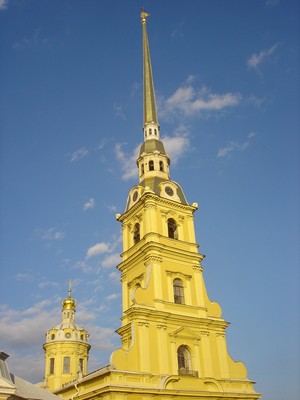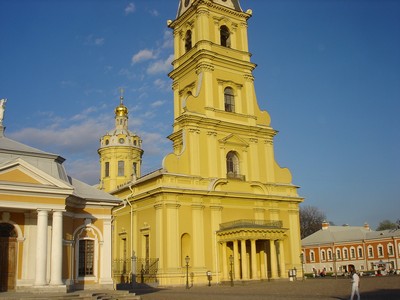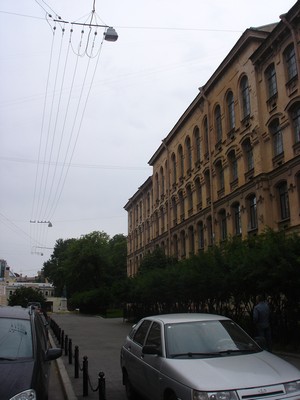|
The European Walkway
The "European Walkway" was set up for the 300th anniversary of Saint Petersburg on the initiative of the European Union. Here is electronic version of this Walkway.
Stations details
|
1. Belgium.
The Carillon - Belgium’s gift tothe Peter and Paul Cathedral of St Petersburg
Carillons are percussion instruments comprising a set of tuned bells, which can be set in motion either mechanically or manually,
with the help of keyboard and pedals. These instruments became widespread in Western Europe from the end
of the 15th century. The music of the Carillon still thrives in the northern part of Belgium,
especially in the city of Mechelen (Malines).
The Carillon appeared in St Petersburg thanks to Peter I. The "sound of Malines’’ became one of the symbols of Peter the Great's
European-oriented Russia.
The original Carillon was completely destroyed in a fire, and only a section of a second Carillon remains today.
However, a new Carillon has recently been created by the outstanding modern-day Carillon maker Jo Haazen. The international project
to create the Carillon, implemented by the Mechelen School of Carillon, the
King Baudouin Foundation, the Government of the Flemish Community of Belgium and their Russian partners, was approved in 1996.
The instrument, constructed with the financial support of foundations and private donors from Belgium and other countries, consists of
51 bells with a total weight of 15,160 kg.
The new Carillon was installed in the bell-tower of the Peter and Paul Cathedral on
15 September 2001, bringing the "sound of Malines" back to St
Petersburg.
Back to station list
|


|
|
2. United Kingdom
Robert Bruce - First High-Commandant of St Petersburg
Robert (Roman) Bruce (1668-1720)
was the descendant of Scottish kings, the son of a general-lieutenant in the
Russian army and an associate of Peter I. By 1700, Bruce had become a colonel
and the commander of a regular infantry regiment, which carried his name -
Regiment of Bruce. He served bravely and assiduously.
In 1704, Tsar Peter I appointed Bruce as the First High-Commandant of St
Petersburg. Bruce struggled with the flooding Neva, repelled attacks by enemy
Swedish forces and reconstructed the Peter and Paul Fortress, while
simultaneously building and equipping the new city.
Bruce served Russia as ageneral-lieutenant and member of the military board until his death in 1720.
Peter I himself joined Bruce’s funeral procession. He was buried beneath
the walls of the unfinished Peter and Paul Cathedral - a high honour, which was
traditionally reserved for royalty.
The burial of Robert Bruce marks the beginning of thehistory of the Commandant's Cemetery at the Peter and Paul Fortress, where only
19 commandants were buried in two hundred years.
Back to station list
|

|
|
3. France
Etienne Maurice Falconet - Sculptor of Bronze Horseman
Etienne Maurice Falconet (1716-1791) - French sculptor, member of the Royal Academy of Painting and Sculpture - was the creator of well known sculptures of "Cupid" and "Bather", director of the sculpture workshop at the Sevres porcelain factory and author of treatises on the theory of art.
The great master arrived in St Petersburg in 1766 at the invitation of Catherine II. Works by Falconet were already well known in the city, and he was elected honorary member of the Russian Academy of Arts.
Falconet devoted twelve years to the creation of the Bronze Horseman monument. In this sculpture he emphasized the constructive character of Peter the Great’s reign. He was assisted in the work by his disciple M.-A. Collot, who created the head of the Emperor. Russian sculptor F.G. Gordeev moulded the snake, E.E. Haylov performed the casting of the monument.
A huge boulder became the statue's pedestal, which was named the "thunder-stone". Falconet chiselled away much of the original boulder to create the image of a cresting wave.
Falconet returned home to France in 1778.
The installation and opening ceremony of the monument took place on 7 August 1782 without its creator.
Back to station list
|

|
|
4. Sweden
Fredrik Lidvall - Swedish architect and designer of the Hotel "Astoria"
Fredrik (Fyodor Ivanovich) Lidvall (1870-1945) was a Petersburg Swede and an outstanding architect of the early 20th century. Over the course of 20 years of intense activity, he constructed 33 buildings in St Petersburg, 14 ofwhich are under state protection as historical monuments.
Banks, housing developments and inter-block public spaces, built in the artistic design of the "northern modern" style, had an influence on the architecture of the capital during this period. The houses built by Lidvall were distinguished by their high quality.
Before the construction of the Hotel "Astoria" in 1911-1912, Lidvall had already been recognised as a master architect. In preparing for the project, the architect was constrained by the extremely strict regulations set by the Academy of Arts. In particular, the Hotel was not to overshadow the view of St Isaac's Cathedral from Bolshaya Morskaya Street. Lidvall achieved this by blending the expressive appearance of the "Astoria" into the
surrounding buildings set on the historic St Isaac's Square. The Hotel "Astoria" became one of the finest hotels in St Petersburg.
Back to station list
|

|
|
5. Portugal
Anton Manuilovich Devier (António Manuel de Vieira) – First general police chief of St. Petersburg
The chancellery of the general police chief was located at this address during the time of Peter I. It was headed by Anton Manuilovich Devier (António Manuel de Vieira, 1682-1745), a native of Potrugal. Invited by Peter I to Russia, he quickly established himself as a general-mayor. A favourite and close assosiate of the Russian Tsar, he was made general police chief in 1718.
All private and public construction works in the city, including the construction of gardens as well as the organisation offerries and entertainment activities were carried out under the direct supervision of Devier. Market rules set by Devier were observed throughout the 18th century. Under his instruction , commerce taking place until midday was to be regulated by fixed prices, while after midday, a free market was allowed to operate. In addition,
he also developed and commissioned a civil code and a system of penalties for infringements of the social order:
“For gambling and drunkenness – whipping and hard labour
For repeated sale of bad products – hard labour
For faulty fumaces – penalty
For dumping dust and sewage into the Neva and its other canals – a whip”.
Asa result of these measures, strict order was established in the capital.
Back to station list
|

|
|
6. The Netherlands
Kornelis Kruys - Associate of Peter I and one of the founders of the Russian Navy
Kornelis Ivanovich Kruys (1657-1727) was an admiral and an associate of Peter I.
He is connected to the history of three European countries - Norway, the Netherlands and Russia.
Invited by Peter I in 1697 to serve as a vice-admiral, Kruys' assignment was to establish the Russian Black Sea fleet. From 1705, he was responsible for establishing the Baltic fleet. Tsar Peter I deeply respected Kruys and in 1712 he was invited to be the proxy father at Peter's wedding.
Kruys' estate became the centre of religious life for Protestants living in St Petersburg. The 'Kirche', which he built in 1708, became the predecessor not only of the Dutch, but also of the French and German reformed churches in Russia.
Kruys was called "the patron of evangelic and reformatory schools of all Russia".
In 1732, the Dutch community established a prayer hall and school in the house at the corner of Moika and Nevsky Prospekt. Between 1831 and 1837, architect P. Jacot created a modern building for the Dutch church. This church played a significant role in the history of the Dutch community. Church services were held until 1927.
Back to station list
|

|
|
7. Germany
Evangelic Lutheran Church of St Peter
Established in 1708, the Community of St Peter was the oldest in St Petersburg and the centre of the German Diaspora in the Russian capital. The present building of the Evangelic Lutheran Church of St Peter was constructed between 1833 and 1837 as a project of a Petersburg German, the outstanding architect Alexander Brullov.
This church, which is the largest of all Lutheran churches in St Petersburg, was also the most widely attended, with around 15,000 parishio¬ners by 1917. The charitable society of the church financed the school Petrischule, an orphanage, kindergarten and hospital, and also provided cheap apartments.
The current building of Petrischule, the oldest school in St Petersburg, was constructed in 1762 by the architect M.L. Hofmann. The school received wide social recognition. One of the principles of the development of the school was tole¬rance - it accepted children of all Christian faiths. By 1910, it had become the largest educational complex in Russia, with some 1,600 pupils studying at one time. The students who finished school with distinction were
awarded a gold ring with an inscription in Latin “To Diligence and Honesty”.
Back to station list
|

|
|
8. Finland
Not found yet.
Back to station list
|
|
|
9. Luxemburg
Info will come soon.
Back to station list
|

|
|
10. Ireland
John Field — lrish composer in St Petersburg
John Field (1782-1637) was an Irish composer, virtuoso pianist and tutor who made his debut in St Petersburg in 1804 in the hall of the Philharmonic Society of Engelgardt's house. Field quickly gained fame as the best pianist in St Petersburg. Russia became the second native land of the talented musician. from where he gained worldwide recognition as a composer and one of the first representatives of romanticism in musical performance. The period is called
"the Field era" in Russian piano music.
Field went down in the history of music as the founder of "nocturne" - a new genre of piano music. He wrote seven concertos for piano with orchestra, a quintet two divertissements, four sonatas, fantasies, rondos, some cycles of variations, eighteen nocturnes, and romances on verses of Russian poets.
Field was St Petersburg's most well-known music tutor during the first quarter of the 19th century. He left behind a whole tradition of piano playing. Field's most outstanding continuer of musical pedagogy was A.G. Rubinstein, the founder of the St Petersburg conservatory.
Back to station list
|

|
|
11. Italy
The Work of the Great Italian Architect Carlo Rossi in St Petersburg
Carlo Rossi (1775-1849), born in Naples, later became a member of the Russian gentry and the most eminent architect in Russia during the period of Classicism. He built St Petersburg as a unified, art-integral architectural ensemble, the first of its kind in the world. Thirteen squares and twelve streets are associated with his name.
Among Rossi's creations are the Mikhailovsky and Elagin Palaces, buildings of the Senate and the Synod, the Imperial Public Library, the pavilions of the Anichkov Palace, the military gallery of 1812 at the Winter Palace and the Military Headquarters - which are some of the most historic architectural symbols of the city.
At the beginning of the 20th century, architect I.A. Fomin wrote: "There will come a time when people will come to see the works of Rossi as they go to Italy to see the masters of the Renaissance".
The architectural ensemble around the Alexandrinsky Theatre is Rossi's largest project, with an area of 37 hectares. It consists of the theatre, two squares and the Theatre street, which connects them. The ensemble comprises two buildings with precisely measured proportions of 218 m in length and a height of 22 m, which is the same as the width of the Theatre street.
In 1923, the street was named in honour of the architect as "Zodchego Rossi Street".
Back to station list
|

|
|
12. Denmark
Life of Russian Empress Maria Fyodorovna in Anichkov Palace
For more than 50 years the Anichkov Palace was connected to the name of Empress Maria Fyodorovna, Danish princess Dagmar (1847-1928), wife of Emperor Alexander III. They were married on 27 October 1866, and their marriage was a happy one. Over the course of 18 years, six children were bom into the family.
Maria Fyodorovna never forgot her motherland.
The walls of the Anichkov Palace were decorated with pictures of her favourite Danish painters, such as Carl Bloch, August Schioett, and Carl Frederick Soerensen.
The Empress was head of the Department of the Institutions of Empress Maria and of the Russian Red Cross. During World War I, she organised a shelter for wounded soldiers in her beloved Anichkov Palace.
While Maria Fyodorovna was a Russian Empress for only 13 years, she was a widow for 34. She suffered many painful experiences, including the death of her husband and her two sons - Alexander and Georgiy. In 1918, two other sons - Mikhail and Emperor Nikolay II - were executed, along with her daughter-in-law and five grandchildren.
Maria Fyodorovna left Russia in 1919 for Denmark, where she lived until her death.
Back to station list
|


|
|
13. Greece
Count Ioannis Capodistria - a Greek serving as a diplomat for Russia
Ioannis (Ivan Antonovich) Capodistria (1776-1831) was a diplomat in the service of Russia who later went on to become the first Governor (Ruler) of Greece.
Invited to Russia by Emperor Alexander I in 1809, Capodistria served as a diplomat for Russia for 18 years. He had an outstanding сareer which culminated in the post of State-Secretary lor Foreign Affairs. From 1816-1822, together with K.V. Nesselrode, he headed the Ministry of Foreign Affairs. Capodistria considered Russia his second native land and enjoyed the full trust of the Emperor, who highly valued his sharp intellect and diplomacy.
Two notable graduates of the Tsarskoselskiy Lyceum served under Capodistria at the Foreign Office: A.S. Pushkin, one of Russia's greatest poets, and the future Minister of Foreign Affairs, Chancellor of the Russian Empire, A.M. Gorchakov.
A diplomat of remarkable talent and rare insight, he made a great contribution by signing the Adrianople peace treaty in 1829, which resulted in the recognition of the right of the people of Greece to national independence. In April 1827, Capodistria was elected Governor (Ruler) of Greece. A victim of political intrigue, he was assassinated on 9 October 1831.
Back to station list
|




|
|
14. Austria
Franz (Frantisek) Von Gerstner - Founder of the first railway in Russia
Franz (Frantisek) Von Gerstner (1796-1840), an outstanding engineer and businessman, was born in Prague into the family of a famous scientist. He arrived in Russia in 1834. His intelligence and energy led him to design Russia's first railway. Having already attracted the attention of the Russian government as a result of his earlier engineering projects, Von Gerstner submitted his plan to Tsar Nikolai I under the title "Regarding the benefits of constructing
a railway line between St Petersburg and Tsarskoye Selo, with an extension to Pavlovsk". The Tsar approved the proposal and encouraged Von Gerstner to begin work immediately.
Construction of the Tsarskoselskaya Railway got underway in the spring of 1836. 2,500 workers and 1,400 soldiers laid the first five-kilometre stretch of track within the first month of construction. Tracks, locomotives and steam engines were imported from Europe.
In November 1836, Russia's first steam locomotive set in motion. Von Gerstner himselfwas the conductor andthousands of people came aboard. He would later recall that his train had "travelled the five-kilometre distance 116 times in the first five days". The project gained wide-spread admiration.
A medal commemorating the opening of the railway was issued in October 1837.
Back to station list
|

|
|
15. Spain
Augustin de Betancourt - Prominent Spanish engineer in the Russian service
Augustin Augustinovich Betancourt (Augustin Jose Pedro del Carmen Domingo de Candelaria de Betancourt у Molina, 1758-1824) was a famous scientist and engineer, and a prominent statesman of Spain and Russia.
In 1808, at the age of 50, Betancourt was accepted to the rank of general-major in the Russian military. By this time, he had already established himself as the designer of the first Spanish balloon, the founder of industrial kinematics and the General Inspector of Communications of Spain.
In Russia, Betancourt was the founder and first director of the Institute of Communications Engineers within the Russian secondary technical education system. He was also an innovator in bridge construction, an inventor in the utilisation of steam machines for multi- bucket excavators and the head of the Committee on Buildings and Hydraulic Works in St Petersburg.
Betancourt was a member of the commission supervising the construction of St Isaac's Cathedral. He designed the base, scaffoldings and mechanisms for the erection of the 112 columns of the Cathedral. The technical proposals of Betancourt enabled his disciple, architect A. Montferrand, to construct St Petersburg's most grandiose Cathedral.
Back to station list
|

|
|